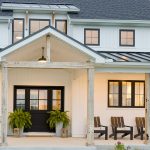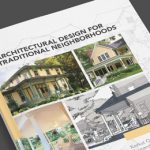As the vinyl siding industry continues to build its case for being the sustainable, eco-friendly choice for home building, it is also positioning its members to be ideal partners for developers who are aligned with the New Urbanism Movement.
New Urbanism is a movement toward town center developments that promote a more humanistic, community-centric lifestyle, with better, more structural architecture. Developments that emphasize superior structure demand more durable and sustainable materials, especially when it comes to architecture.
To help meet this demand, the Vinyl Siding Institute (VSI) will be launching their Architectural Design for Traditional Neighborhoods Program later this spring. Consisting of industry leaders and strategic partners like the prestigious Pel-Ona Architects & Urbanists firm from Boulder, Colorado, the work group will be the essential vehicle for VSI and its members to go to market.
“The industry is embracing the New Urbanism concept, and has been developing innovations to meet the higher architectural demand,” says Matt Dobson, VSI’s Vice President. “Our work group has put together a program that will showcase the exteriors and other products that are not just suitable to these developments, but superior to the competition.”
A big component of VSI’s New Urbanism Work Group mission will be to educate architects, town founders, builders, and developers on the benefits of architectural polymers. With help from Pel-Ona, one key initiative will be the release of the book Architectural Design for Traditional Neighborhoods and the Materials Array Box.
A Movement Away from Suburban Sprawl
New Urbanism started in the early 90s as a response to suburban sprawl developments that emphasized speed over structure, bedroom and “back-porch” living over mixed-use neighborhoods, and isolation over the traditional urban community.
New Urbanism developers consciously identify as such (with many calling themselves “town founders”), designing neighborhoods that accommodate “foot access” from home to work and to “third place” localities like the bar, the park, the library, or a favorite recreation.
Key components of a New Urbanism development include homes with front porches and narrow lots; narrow streets with buildings that face each other; trees, park benches and wide comfy sidewalks that affect car velocity, and a neighborhood in which all homes surround a park, a community garden, or some other public space that entices children to play and adults to congregate.
New Urbanism accounts for at least 5-10% of all recent developments, but its influence is much greater.
“In the residential development world, I believe it’s the most influential movement EVER,” claims affordable housing builder and designer Fernando Pages Ruiz.
“Even though they may not call themselves ‘New Urbanist,’ there are more developments that are influenced by this style. The concept sells, and people like it.”
Ruiz cites the mainstreaming of form-based code as another example of New Urbanism’s heavy influence. As opposed to conventional zoning which tends to separate public space from private space, form-based code shapes developments to achieve an urban form, with an intentional interaction between streets, blocks and buildings in terms of form, scale and massing, as well as the use of frontage areas.
“I was at the (International)Builders Show last February and even the most mainstream builders were talking about narrow lots, smaller homes, no garages and other ways of ‘filling the missing middle’ that New Urbanism emphasizes.”
The movement has been driven by The Congress for the New Urbanism (CNU) which was founded in 1993 by architects, planners, engineers, developers, and urban designers who were frustrated with dispersed, grid-like developments that were isolated from community living.
Why Vinyl Siding for New Urbanism Developments? Here are 5 Big Reasons…
- It’s affordable! New Urbanism Developments can be expensive, but Ruiz believes that prices will come down as the concept grows. “It is easier to achieve an accessible price point with vinyl.”
- It’s more durable and can meet structural demands. You can achieve a high level of architectural authenticity relatively easily with vinyl.
- IT’S MUCH GREENER THAN BRICK, FIBER CEMENT AND OTHER EXTERIORS. The New Urbanism Work Group will be working closely with VSI’s Sustainability Work Group to create greater awareness of vinyl siding’s green advantages.
- Vinyl offers more variety! You can do a whole set of row houses with assorted colors and styles using the same product that complies with form-based code.
- It’s easier and faster to install. There are a lot of problems and inefficiencies with masonry and fiberboard cement that vinyl eliminates.
Overcoming Vinyl Siding’s Two Biggest Obstacles to Entering the New Urbanism Market
To gain entry and a reasonable market share in the New Urbanism market, the VSI’s New Urbanism Work Group has to address two significant hurdles:
- Vinyl siding’s association with suburban sprawl developments. Purists in the New Urbanism movement have been quick to dismiss vinyl siding and polypropylene products from their specs because it was so popular for home suburban developments. As Ruiz asserts, “Don’t blame the product. Blame the design!”
- Educating the architects and designers on how vinyl really works. “Many anti-vinyl architects are friendly towards it now that they know about the advantages,” Ruiz claims, “like using polypropylene shake and poly-ash for mitered corners. You can do a lot with it, including a whole new pallet.”
A paramount resource in helping the industry overcome these obstacles will be the Architectural Design for Traditional Neighborhoods Program that the New Urbanism Work Group is launching later this spring. It will serve as the outreach initiative to encourage the use of new urbanism concepts and make a strong case for specification of innovative polymeric products made by VSI members.
The program will shed light on the variety, innovation and versatility of all vinyl claddings, trim, cellular PVC, and other polymeric architectural products manufactured by VSI members. The Work Group plans to launch the Architectural Design for Traditional Neighborhoods Program at CNU’s 27th Annual Congress this June (12-15) in Louisville and then conduct AIA accredited programs in the second half of 2019 to architectural and New Urbanist groups.
“I am excited to see the reactions when the Architectural Design for Traditional Neighborhoods Program is provided to architects, town planners, and developers who are involved with the New Urbanism Movement,” says Dobson. “I am confident that they will find our products to be invaluable resources for responsible neighborhood developments.”
Don Browne is a writer and entrepreneur who believes that the power of words can change the world. He provides unique writing services for clients in the construction, health care, IT and hospitality sectors. He has a passion for small business and start-ups, as well as writing about Irish history, family and corporate biographies. As a homeowner and father of four, Don looks forward to writing more about sustainability issues within the housing industry.

